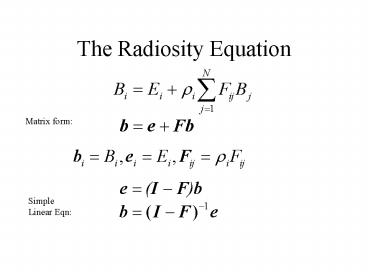The Radiosity Equation - PowerPoint PPT Presentation
Title:
The Radiosity Equation
Description:
Use the computed radiosities as the intensities of the patches. No lighting when rendering ... Requires strictly diagonally dominant: Displaying the Results ... – PowerPoint PPT presentation
Number of Views:40
Avg rating:3.0/5.0
Title: The Radiosity Equation
1
The Radiosity Equation
Matrix form
Simple Linear Eqn
2
Simple Solution Strategy
- Provide the geometry of the scene
- Provide the surface properties (?i, Ei)
- Construct F
- Solve the system
- Use the computed radiosities as the intensities
of the patches - No lighting when rendering
3
Jacobi Relaxation
- Jacobi relaxtion Start with a guess for Bi, then
4
Gauss-Seidel Relaxation
- Uses values from current iteration
- Allows updating in place
- Requires strictly diagonally dominant
5
Displaying the Results
- Color is handled by discretizing wavelength and
solving each channel separately - Smooth shading
- Patch radiosities are mapped to vertex colors by
averaging the radiosities of the patches incident
upon the vertex - Per-vertex colors then used to Gourand shade
6
Value for Computation
- Most of the time is spent computing form factors
- must solve N visibility problems - However, same form factors for different
illumination conditions - Result is view independent - have radiosities for
all patches. May be good or may be wasteful
7
Form Factor Computations
- Direct integration
- Conversion to contour integration
- Form factor algebra
- Monte Carlo integration
- Projection methods
- Hemisphere
- Hemicube
8
Direct Integration
- Only works for simplest cases
There is a formula for 2 isolated polygons, but
it assumes they can see each other fully!
9
Contour Integral
- Use Stokes theorem to convert the area integrals
into contour integrals - But, still only works for unoccluded patches
- Care must be taken when r?0
10
Form Factor Algebra
- Use the properties of form factors and direct
integration to compute new form factors - Additivity
- Reciprocity
- Point to disc form factors
- Rectangle to rectangle form factors
- Difficult to apply automatically
- Useful only in tiny scenes
- Unoccluded case only
11
Projection Methods
- For patches that are far apart compared to their
areas, the inner integral in the form factor
doesnt vary much - So, compute point to patch form factors and weigh
by area
12
Nusselts Analogy
- Integrate over visible solid angle instead of
visible patch area
Fx,P is the fraction of the area of the unit disc
in the base plane obtained by projecting the
surface patch P onto the unit sphere centered at
x and then orthogonally down onto the base plane.
13
The Hemicube
- We dont have to project onto a sphere
- We have algorithms, and even hardware, for
projecting onto planar surfaces - The hemicube consists of 5 such faces
14
Hemicube, cont.
- Pretend each face of the hemicube is a screen,
and project the world onto it - Code each polygon with a color, and count the
pixels of each color to determine C(j) - Quality depends on hemicube resolution and
z-buffer depth
15
Overview
- Input geometry and surface properties
- Find form factors
- Solve the system
- Output geometry with per-face or per-vertex
intensities






























